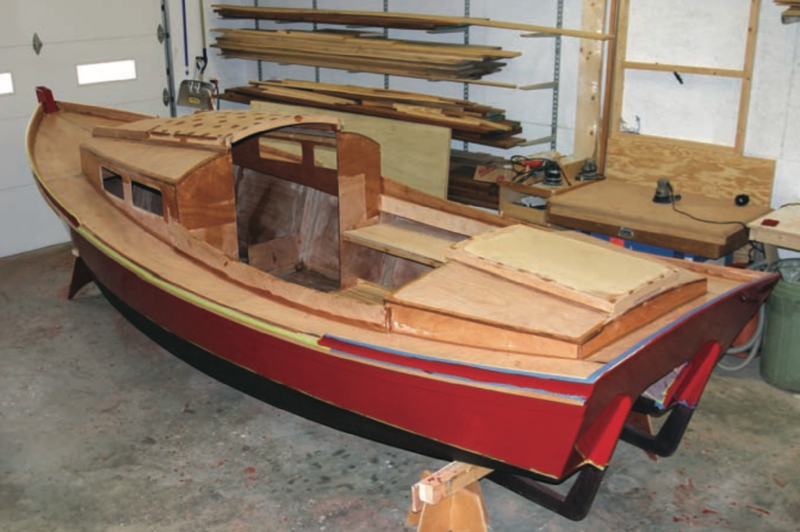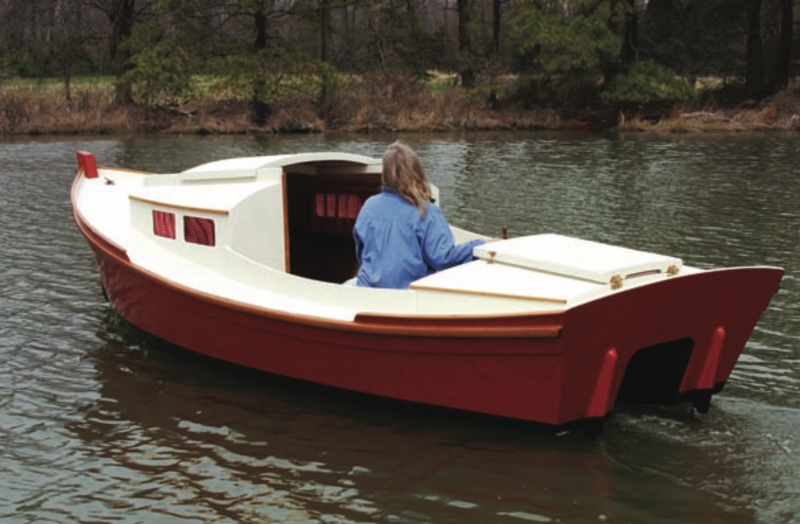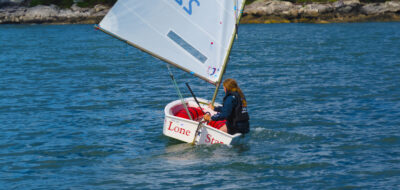
18'6" Outboard Skiff Cruiser, Redwing
The original print version of this article can be viewed as a PDF or purchased from the WoodenBoat Store.
Join to view PDF Purchase 18'6" Redwing PlansInspired by an old Howard Chapelle design (see WB No. 82, page 114), Karl Stambaugh demonstrates that we need not mimic the short, fat, and inefficient stock outboard cruisers of the 1950s.

Redwing provides pleasant, airy accommodations for her crew and for the engine. A Chesapeake-style sunshade can be rigged over the cockpit.
Redwing’s nicely proportioned hull will be easily driven at moderate speeds in more or less protected waters. Although 5 hp will do the job, a 10-hp, four-cycle outboard would be a nearly perfect (if somewhat expensive) match. Quiet, dependable, and economical of fuel, these motors are loved by all who own them. To reduce noise, Stambaugh drew an insulated motorwell. We suspect you’ll hear the hiss of the bow wave during lulls in conversation. As with all motorwells, you should provide adequate ventilation and check that the well’s dimensions will permit your motor to tilt up fully.

Inboard profile
Unlike the traditional skiff construction specified by Chapelle, Stambaugh calls for sheet plywood and epoxy. Short of being holed, a hull built to these plans has no excuse for leaking a single drop, ever-a desirable characteristic, as bilgewater in flat-bottomed boats soon invades the accommodations. And Redwing’s plywood hull can live happily on a trailer.

Profile and body plan
Stambaugh’s drawings are filled with worthwhile details. For example, he shows a drip groove routed into the bottom of the rubrails. Gravity and surface tension will cause water flowing from the deck to drop from the rails at the groove rather than running down, and staining, the topsides.

Arrangement plan
Because of her relative silence and sharp control, the Redwing outboard skiff will be welcome in most any harbor. But we see her as in the evocative sketch on the title page of this book: pressing far upstream past the cattails.
Redwing design plans contain four sheets, including the arrangement plan, hull lines and offsets, and construction drawings. WB Plan No. 108, $70.00.
18′ 6″ Outboard Skiff Cruiser, Redwing Design Highlights
DESCRIPTION
Hull type: Flat-bottomed
Construction: Plywood planking over sawn frames
Headroom/cabin (between beams): About 3′ 6″
PERFORMANCE
* Suitable for: Protected waters
* Intended capacity: 1-4 day tripping, 2 cruising
Trailerable: Yes
Propulsion: 5-10 hp outboard engine
Speed (knots): Up to 6
BUILDING DATA
Skill needed: Intermediate
Lofting required: Yes
* Alternative construction: None
PLANS DATA
No. of sheets: 4
Level of detail: Average
Cost per set: $70.00
WB Plan No. 108
Completed Outboard Skiff Cruiser, Redwing Images
 Photo by Bill Thomas
Photo by Bill ThomasDesigner Stambaugh estimates the materials cost for a Redwing 18 at about $5,000 (not including power). This figure assumes high-quality materials and finish.
 Photo by Bill Thomas
Photo by Bill ThomasThe motor lives in an enclosed box, and is nearly silent. Cruising speed is about 6-9 knots, depending on choice of power.
 Photo by Bill Thomas
Photo by Bill ThomasAt only 850 lbs, Redwing is of an ideal weight to tow behind an average car. But she’s also capacious, and will carry a couple and their gear on an expedition.












Wonder why someone does not take a cue from the wonderful fiberglass small cruisers from England and build in Plywood and Epoxy. They are ultra efficient as Fuel is so expensive there for the everyday sailor and the layout is fantastic.
I wonder if you would be good enough to give me the names of some of the designs that you are thinking of.
Wondering about the large triangular openings in the twin skegs. Wouldn’t they create drag? Aside from that, what is the purpose of those openings?
Can this boat be rowed?
Also, any thought to adding a sail like a balanced lug rig with leeboards?